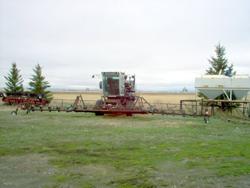
Cal Cowan of Moose Jaw, Sask., is pleased with the weed control he's achieved with his giant self-propelled weed whacker mounted on front of a combine.
He says the unit works great to knock out mustard and kochia in his organic lentils, peas and flax crops. Cowan says the "ragged chop" of the machine fractures the stems, causing more damage.
Cowan started with a 1974 F2 Gleaner combine and stripped it down before mounting a diesel motor where the hopper had been. This 160-hp engine was salvaged from another old Gleaner combine and is used to power a hydraulic pump, which operates the weed whacker blades.
He kept the combine's original tires and says they're narrow enough to work well.
Where the combine's header used to be, Cowan built a new 40-ft. platform. A 1 by 3/8-in. U-channel frame holds eighteen 27-in. steel blades that are made from 1/4-in. flat metal. Each one is powered by a 2,700-rpm orbit motor. The blades are staggered and overlap slightly to ensure complete coverage.
"Thanks to rubberized cushioners where the motor shaft joins the blade shaft, there's a bit of give if you hit something, and it won't break the shaft on the orbit motor," he explains. "The blades turn at 2,700 rpm's and there is a tiny shear pin in each one, so if a blade hits something solid it will just drop down. You don't have to worry about it flying out or anything."
The 40-ft. platform is hinged in two places (creating three sections), and the two track wheels on each end allow the boom to follow the contour of the land. Hydraulic rams lift the boom's wings up for transport.
"I've got a 200-gal. hydraulic oil reservoir mounted below where the chaffer used to be. In this location, the hydraulic oil stays a bit cooler, but I've also got a cooling fan mounted on the side of the combine, next to the reservoir tank," Cowan explains.
A large 3-in. dia. hose feeds the hydraulic pump and two 2-in. dia. hoses return oil to the reservoir.
Height adjusts from 1 to 14 in. and the boom tilts hydraulically, controlled from the cab.
Depending on moisture conditions, Cowan can weed whack 30 acres per hour, travelling 6 to 7 mph.
He says the machine works great for thistle patches, and he also uses the weed whacker to chop standing straw in the spring. (His combine's stripper header removes the heads of his cereal crops, and leaves three feet of straw to catch snow over the winter.)
Cowan says there are only a couple of things he wishes he had done differently.
"Instead of separate gas and diesel engines, I'd use one larger motor for everything, and I might design the boom a little differently."
Cowan got a lot of assistance from Assiniboia, Sask. organic farmer Dwayne Woolhouse, who had built a belt-driven mechanical weeder on a swather. He also hired a local shop specializing in hydraulics to "do the specs" on what he was going to need for horsepower, oil volume, speed, etc. The schematic diagrams they provided, gave Cowan confidence that the system would be correctly configured with appropriately sized components.
